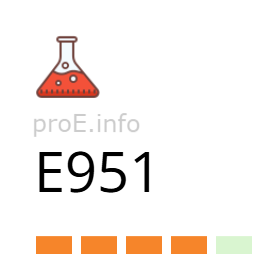
Other names for the additive (synonyms)
General Information
Aspartame (food additive E951) is a synthetic, non-sugar sweetener widely used in the food industry as a sugar substitute.
Aspartame was first synthesized in 1965 by chemist James M. Schlatter. A few years later, after necessary studies were conducted, it was approved for use in food products. In 1981, the sweetener began to be used in the USA and the United Kingdom and later gained worldwide distribution as an alternative to sugar and the previously popular saccharin, which had raised concerns regarding carcinogenicity.
Chemically, aspartame is a methyl ester of a dipeptide consisting of two standard amino acids — aspartic acid and phenylalanine. The molecular formula of the compound is C14H18N2O5.
The organoleptic properties of aspartame differ from regular sugar: its sweetness develops more slowly but lasts longer in the mouth. Additive E951 has no odor, is easily soluble in water, and is approximately 200 times sweeter than sugar. Its caloric value is extremely low, as only a minimal amount of the additive is needed to achieve the desired sweetness of the product.
A significant limitation of using additive E951 is its thermal instability: aspartame decomposes at around 80 °C, so it is not used in products subjected to intensive heat treatment.
Effects on the Body
Benefits of additive E951
The amino acids into which aspartame is broken down in the body — phenylalanine and aspartic acid — are natural components of proteins necessary for human health.
The main advantage of aspartame is the ability to consume sweet foods without significantly increasing caloric intake. This is especially important for people aiming to reduce weight or limit sugar intake in cases of diabetes and metabolic syndrome. Thanks to its high sweetness, aspartame allows a significant reduction in the burden on carbohydrate metabolism.
Risks of additive E951
The metabolism of additive E951 produces a small amount of methanol, which is a toxic substance. However, in these doses, it does not pose a threat to humans. Aspartame’s contribution to total methanol intake does not exceed 10%, which is considered safe for the body.
The main risk factor when consuming aspartame is phenylalanine, formed during its breakdown. For healthy individuals, this is not an issue, but for people with the rare inherited disorder phenylketonuria (PKU), even small amounts of this amino acid can be dangerous. Therefore, in many countries, products containing additive E951 are required by law to include a warning about phenylalanine content.
Scientific literature contains extensive data on aspartame’s safety. Toxicological studies have shown extremely low acute and chronic toxicity. No genotoxic or mutagenic potential has been identified. Long-term experiments on rats and mice have also not confirmed any carcinogenic effects.
Nevertheless, some publications, primarily studies by the Italian Ramazzini Foundation, sparked discussion as they reported increased frequencies of lymphomas and leukemias in rats. EFSA and other expert bodies deemed the methodology of these studies questionable and did not change existing conclusions.
Large cohort studies, such as the French NutriNet-Santé (2022), found an association between high consumption of artificial sweeteners, including aspartame, and an increased risk of certain types of cancer. However, the authors themselves noted limitations of observational data and the impossibility of excluding confounding factors.
Such results were considered “signals” but did not serve as a basis for revising regulatory standards.
In 2023, the International Agency for Research on Cancer (IARC, WHO) classified aspartame as “possibly carcinogenic to humans” (Group 2B), citing limited human data and conflicting results from some studies.
At the same time, the Joint FAO/WHO Expert Committee on Food Additives (JECFA) confirmed the acceptable daily intake (ADI) of up to 40 mg per kilogram of body weight per day.
The European Food Safety Authority (EFSA) also conducted a review and concluded that consumption of additive E951 within the ADI of 40 mg/kg body weight per day is safe for all population groups, except for patients with phenylketonuria.
Thus, the scientific consensus of expert organizations is that aspartame poses no danger to healthy individuals when consumed within recommended limits, and the risk is limited solely to phenylalanine in patients with phenylketonuria.
Uses
Aspartame is primarily used in low-calorie and diet products. It can be found in carbonated soft drinks, chewing gums, candies, confectionery products, desserts, and some dairy products.
Due to its high sweetness intensity and lack of aftertaste, additive E951 is often combined with other sweeteners to create flavor profiles similar to sugar.
A notable feature of additive E951 use is its limited heat stability. Unlike acesulfame K or sucralose, aspartame is not suitable for baking or cooking hot dishes and is therefore mostly used in beverages and cold desserts.
Legal Status
Aspartame is approved for use in the food industry in most countries worldwide, including the European Union, the USA, Canada, the United Kingdom, Japan, Australia, and Ukraine.
In the EU, it is regulated under Regulation No. 1333/2008 and included in the specifications of Regulation No. 231/2012. The acceptable daily intake (ADI) is set at 40 mg/kg body weight.
In the USA and Canada, the equivalent value is 50 mg/kg body weight. In the USA, aspartame has GRAS status (Generally Recognized As Safe), meaning it is recognized as safe for use in food products when consumed according to FDA-established guidelines.
Products containing aspartame must include labeling about its presence as well as a warning about phenylalanine. This requirement applies in all countries where additive E951 is officially used.
Despite ongoing scientific discussions, such as the IARC classification, regulatory bodies — EFSA, JECFA, and FDA — confirm the safety of aspartame when consumed within established limits.